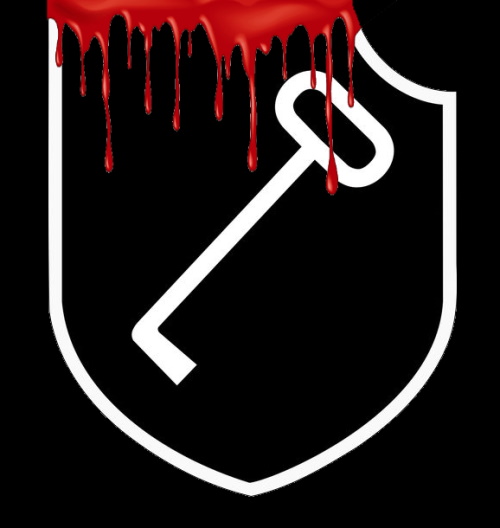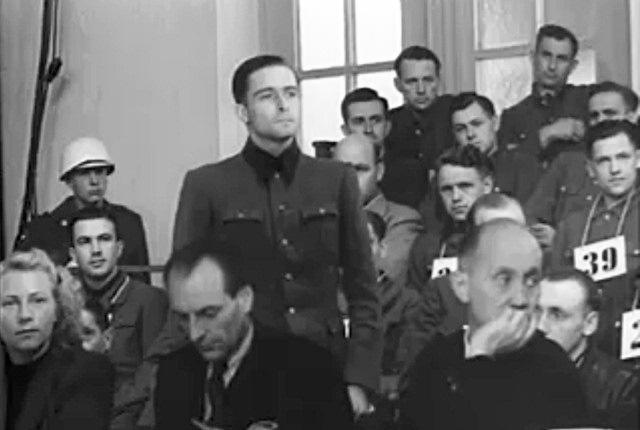 (Freising) Investigation, Malmédy case. E.C.B. File N° 624, Examination of prisoner of war, 25, 26 August 1945, in Freising, Germany. This is not to be confused with the Hechler historical interview in September. It was a sworn statement. During a telephone conversation on June 24, 1952, Col Ellis explained to the writer that at Freising, Peiper drew upon his memory, lacked knowledge of what the prosecutor knew or did not know, and Ellis felt the tactical data recorded at Freising generally was factual. Later, during the trial, Peiper was on the defensive and attempted to disassociate himself from atrocities. One such means was to name attack hours or time of his presence at variance with other witnesses.
(Freising) Investigation, Malmédy case. E.C.B. File N° 624, Examination of prisoner of war, 25, 26 August 1945, in Freising, Germany. This is not to be confused with the Hechler historical interview in September. It was a sworn statement. During a telephone conversation on June 24, 1952, Col Ellis explained to the writer that at Freising, Peiper drew upon his memory, lacked knowledge of what the prosecutor knew or did not know, and Ellis felt the tactical data recorded at Freising generally was factual. Later, during the trial, Peiper was on the defensive and attempted to disassociate himself from atrocities. One such means was to name attack hours or time of his presence at variance with other witnesses.
(Honsfeld and La Gleize) As to Oberstleutnant Siegfried Taubert and his Parachute Battalions, In Direct, Peiper indicated the Taubert Group participated in the Honsfeld action but was left there due to orders misunderstanding and that he said Taubert he had to await regimental orders. In Cross, the Freising statement was read: I ordered him to immediately mount all his paratroopers on my vehicles, to advance with me at top speed to take Büllingen. Tauber required Division orders, and Peiper angrily told him to stay in Honsfeld. In Cross, Peiper added he had forgotten to mention in Freising: he found out that he had a company of paratroopers with him for the first time in La Gleize while attacking Stoumont.
(Büllingen) In Direct, Peiper said he entered it about 2100 or 2130. In Cross, he was uncertain as to 2000 or 2100.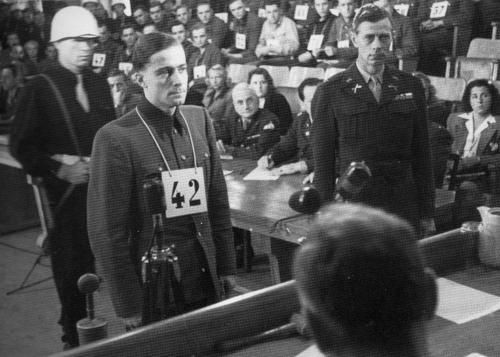
(Baugnez) Both, In Direct and In Cross were too complicated, pertained primarily to the atrocity aspect. Suffice it to say Peiper was there.
(Ligneuville) Same as Baugnez, except his Direct was likely acceptable for tactical matters with two exceptions. The arrival time was noon, not 1400, according to Cross and Freising, but Peiper would not agree to that. Second exception: A Sherman tank was knocked out, but by whom or how was not clear.
(Stavelot) Arrival, but not entry, time of both Direct and cross was about 2000 or 2100, December 17. Cross added these tactical details : Peiper did not go into Stavelot upon arrival. It was impossible to take the town. The whole town was full of American vehicles and a very large number of columns were passing the town from the north to northwest. With the weapons at our disposal, we fired into the town and attempted at least to disturb the traffic of these columns. Then an American column attacked the road, but I can say with certainty whether this was in the evening, or, the early morning hours. This attack was conducted by American infantry to our left flank. I have already described yesterday how the terrain was much higher on our left.
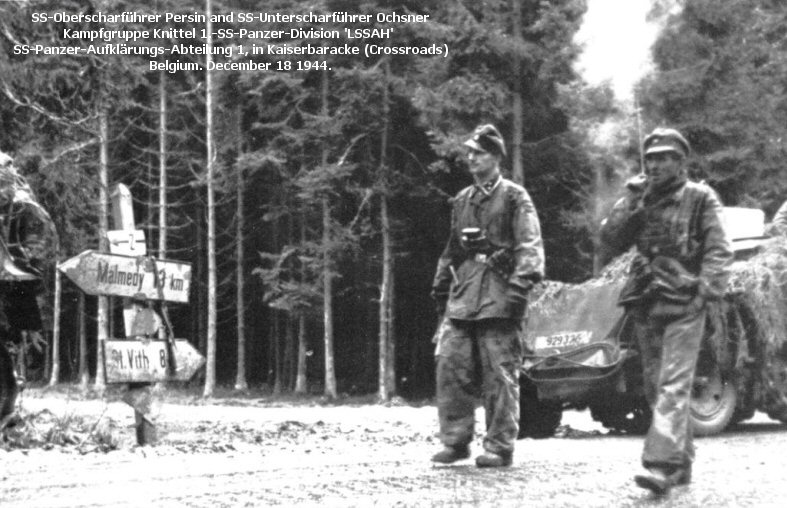 We were in a closed formation on the road at the time of this attack and we defended against the attack by directing our fire from the weapons on our vehicles to our left — the direction of the attack. That attack was at night or in the early morning hours. It is possible that it was getting night already. His Direct did not indicate a time of his own attack, but the Cross estimated about 0800, and he did not know his Freising answer as to that time. He spent the night in Diefenthal’s vehicle, then in the morning before his attack, had a conference in a house next to the river, about 800-1000 meters southeast of Stavelot.
We were in a closed formation on the road at the time of this attack and we defended against the attack by directing our fire from the weapons on our vehicles to our left — the direction of the attack. That attack was at night or in the early morning hours. It is possible that it was getting night already. His Direct did not indicate a time of his own attack, but the Cross estimated about 0800, and he did not know his Freising answer as to that time. He spent the night in Diefenthal’s vehicle, then in the morning before his attack, had a conference in a house next to the river, about 800-1000 meters southeast of Stavelot.
During Cross, the following Freising statement was read in response to a query as to the time he started out on the morning of Dec 18: I would like to say the following first: during the night I committed an armored group – that is to say a weakened panzer company, which had the mission of reaching Trois-Ponts by way of Wannerenval and Aisomont. During the night, I only received one me from this company which notified me that they were running into severe terrain difficulties. Also on Dec 18, at 0600, I started the attack in Stavelot. At this time much demolition could be seen in Stavelot, especially three large gas dumps. The infantry advanced to the outskirts of the city, but they were stopped because of a heavy trap that had been erected there which Sherman tanks and AT weapons. Beside this, we were drawing artillery and AT fire from the northern flank.
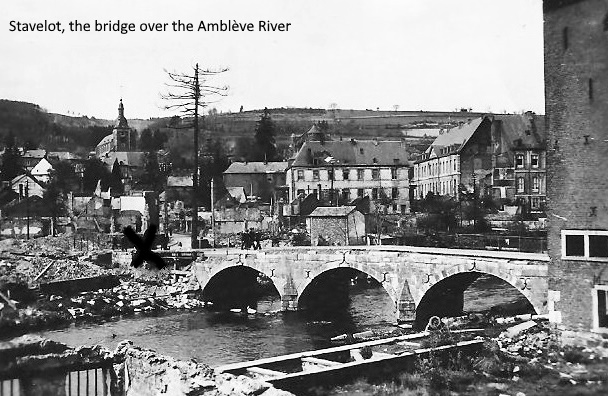 Because we had to take the bridge at Stavelot at any cost, before it was destroyed, I now had to advance at all costs. I gave the order to three Panthers to take a running start and at top speed crashes down on to the tank trap.
Because we had to take the bridge at Stavelot at any cost, before it was destroyed, I now had to advance at all costs. I gave the order to three Panthers to take a running start and at top speed crashes down on to the tank trap.
(Question) Now, is that answer correct?
(Answer) In the main, that answer is correct.
(La Gleize (first time) and Cheneux) Details of the Direct should be compared with the following of the Cross: Peiper just rode through, which might have taken about 3 minutes. The middle part and the end of my column didn’t go through La Gleize at all, since I had already turned around at the time when they reached La Gleize and I ordered that that part of the column following would be stopped.
(Question) At what time did you reach Cheneux?
(Answer) I had an air attack outside Cheneux; this was about 1230, in my estimate. The air attack delayed us for about two to two and a half hours, as I have mentioned. In other words, that means that we arrived at Cheneux at about 1530 or 1600. He was sure!
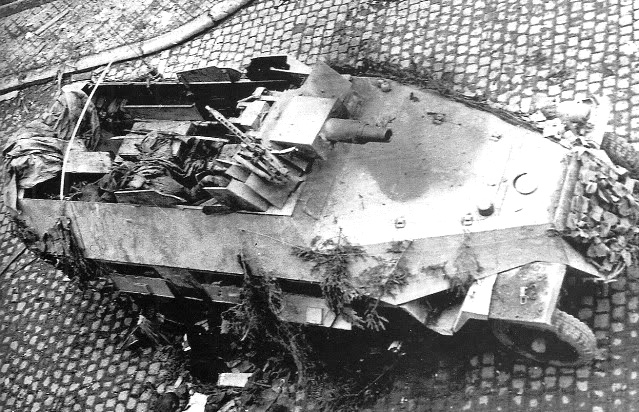 (Stoumont) Direct testimony was that although (Dec 19) Peiper planned a dawn attack. Fog, delayed it until 0900, Dec 19. Cross strove to make Peiper admit the attack and capture of the PWs was 0600-0800. Cross read Direct which Peiper said was correct. Then, when Peiper denied the 0600-0800 hours, Cross read the following statement: After my recon had given me a clear picture of the enemy situation in Stoumont, I assembled for the attack at approximately 0600 on the morning of Dec 19. The troops that I had with me at that time was a grand conglomeration and mixture of all the units that I had with me at that time. I had tanks from my own regiment, panzer grenadiers from the 2.Regiment, an AAA unit of the Luftwaffe, an artillery battalion from our own division artillery, and at least one reinforced company of Fallschirmjäger, which were mounted on my tanks during the whole advance.
(Stoumont) Direct testimony was that although (Dec 19) Peiper planned a dawn attack. Fog, delayed it until 0900, Dec 19. Cross strove to make Peiper admit the attack and capture of the PWs was 0600-0800. Cross read Direct which Peiper said was correct. Then, when Peiper denied the 0600-0800 hours, Cross read the following statement: After my recon had given me a clear picture of the enemy situation in Stoumont, I assembled for the attack at approximately 0600 on the morning of Dec 19. The troops that I had with me at that time was a grand conglomeration and mixture of all the units that I had with me at that time. I had tanks from my own regiment, panzer grenadiers from the 2.Regiment, an AAA unit of the Luftwaffe, an artillery battalion from our own division artillery, and at least one reinforced company of Fallschirmjäger, which were mounted on my tanks during the whole advance.
I had at the most 6 tanks (Mark VI-2 Tiger) from the 2.Panzer-Battalion, and because of the speed with which we were advancing after Stavelot, they were unable to keep up with us. The attack on Stoumont was a difficult one because I couldn’t attack with an extended armored front and the leading vehicles could only fight from the road. Enemy resistance was great and was being constantly fed by troops coming from the north and the west. This was the first time that I realized that strengthened American opposition was in the making.
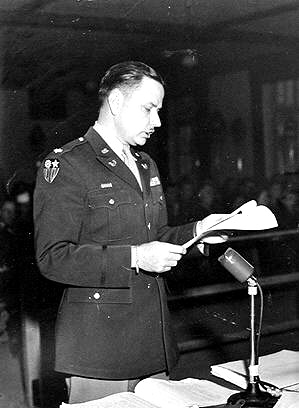 After about 2 hours of combat, the town was taken by my tanks. We captured approximately 200 American soldiers. The beaten enemy was followed for approximately 5000 meters and then we had to stop because we didn’t have a drop of gasoline left. At this time, I tried to take up communication with my division by radio to ask them what steps had been taken as far as Stavelot was concerned and when I could figure on supplies coming on to me.
After about 2 hours of combat, the town was taken by my tanks. We captured approximately 200 American soldiers. The beaten enemy was followed for approximately 5000 meters and then we had to stop because we didn’t have a drop of gasoline left. At this time, I tried to take up communication with my division by radio to ask them what steps had been taken as far as Stavelot was concerned and when I could figure on supplies coming on to me.
(Question) Is that answer correct?
(Answer) No!
 Despite the negative answer, maybe both that Freising statement – except for the attack hour, and the Direct about Stoumont, were rather reliable descriptions of the tactical situation, as distinct from atrocity angle. The former prosecutor, Col Burton F. Ellis, in a telephone conversation of Jun 24, 1952, pointed out the Freising statement tended to be factual as to operational subjects, because it was well before the trial, and Peiper was not so much on the defensive. It may be noted that the Cross seemed to be concerned only with the attack time, to prove Peiper was a participant. Maybe the American story can verify or not some of both the Direct and Freising statements.
Despite the negative answer, maybe both that Freising statement – except for the attack hour, and the Direct about Stoumont, were rather reliable descriptions of the tactical situation, as distinct from atrocity angle. The former prosecutor, Col Burton F. Ellis, in a telephone conversation of Jun 24, 1952, pointed out the Freising statement tended to be factual as to operational subjects, because it was well before the trial, and Peiper was not so much on the defensive. It may be noted that the Cross seemed to be concerned only with the attack time, to prove Peiper was a participant. Maybe the American story can verify or not some of both the Direct and Freising statements.
Direct had brought out Peiper conferred in La Gleize about 1230 on Dec 19 with the 1.SS-Panzer-Recon-Battalion, Knittel, who reported that the enemy had completely taken Stavelot again, and Peiper had sent Knittel back to retake the town. The statement was read during Cross and Peiper claimed he had not said completely taken, but we had serious difficulties with the enemy at Stavelot. Peiper said that a translation error in the Direct testimony had been made, adding that was his only change. There was further reading of a Freising statement, which contained the list of the tactical matters but placed the conference hour as 1000. In a word, these references to a La Gleize conference on Stavelot were part of the prosecution’s effort to implicate Peiper in the Stoumont atrocity, by means of establishing his movements to the hour. Peiper was obviously in the named towns, the precise hour debated by him and the prosecution.
 SS-Brigadeführer Fritz Ludwig Karl Kraemer
SS-Brigadeführer Fritz Ludwig Karl Kraemer
(Chief of Staff – 6.Panzer-Army)
 The following extracts or information were from his testimony during the Malmédy Massacres Trial in Dachau, Germany, Jun 1946.
The following extracts or information were from his testimony during the Malmédy Massacres Trial in Dachau, Germany, Jun 1946.
(A) He gave me many details of the formation of the 6.Panzer-Army prior the counter-offensive, and other Ardennes data. This may supplement other data from him e.g. historical interviews and papers sent to Col S.L.A. Marshall. This folder of Kraemer’s testimony can be obtained, doubtless, from Col Burton F. Ellis.
B (Deactivation of Kampfgruppe Peiper) Direct Examination by Defense, pp. 1862, 6.Panzer-Army, participated in the Ardennes offensive from Dec 16, 1944, until approximately Jan 20, 1945. Then, the Headquarters were, together with the 1. and the 2.SS-Panzer-Corps, moved by train beginning Jan 18. They were committed to action in Hungary in early March.
(I.SS-Panzer-Corps) I.SS-Panzer-Corps Sector: Corps and Divisions were changed very frequently during the action. The I.SS-Panzer-Corps together with the 1.SS-Panzer-Division (LSSAH) and the 12.SS-Panzer-Division (HJ) was relieved on Dec 28, 1944, and they were sent to the 5.Panzer-Army during the period Dec 27 and Dec 30. SS-Oberst-Gruppenführer Josef Dietrich and also Field Marshal Walter Mödel found out that the Ordnance Company of the 1.SS-Panzer-Division had remained behind in the forest, in other words, in St-Vith (Belgium).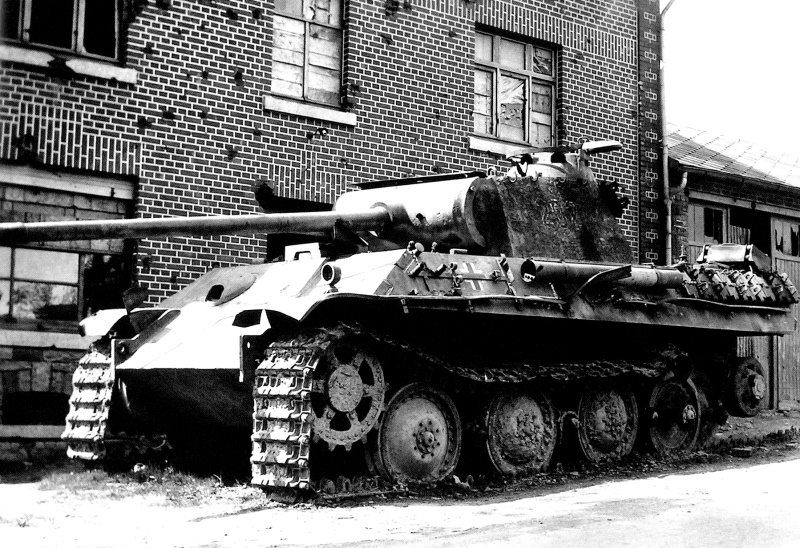 That was not known to the Army, and that occurred upon the investigation of the Division. I did not know the number of men, I only knew that 10 or 12 tanks were repaired there.
That was not known to the Army, and that occurred upon the investigation of the Division. I did not know the number of men, I only knew that 10 or 12 tanks were repaired there.
(Redirect Examination by Prosecution (Question) You said on Direct examination that the 1.SS-Panzer-Regiment was withdrew from the offensive about Dec 28, 1944, if I recall correctly?
(Answer) That is not correct, I did not say it this way.
(Question) What did you say then?
(Answer) I stated that the 1.SS-Panzer-Division was transferred to the 5.Panzer-Army on Dec 27 or 28. At the beginning of Jan 1945, I found out that the damaged 1.SS-Panzer-Regiment did not get to the 5.Panzer-Army, but the Tanks had to remain behind in the woods east of St-Vith. I further told you that the 1.SS-Panzer-Division was transferred to Hungary on Ja 20, 1945. Therefore the 1.SS-Panzer-Regiment was still in Belgium up to and including Jan 13, 1945.
(Question) Is that correct?
(Answer) Yes that is correct.
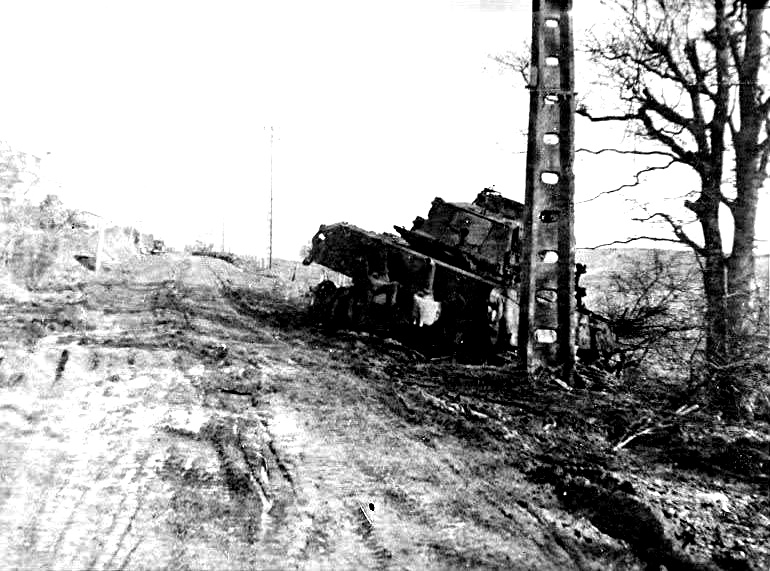 (Redirect Examination by Defense) (Question) From the Regiment of Peiper did only the Ordnance Company or the whole Regiment remain behind?
(Redirect Examination by Defense) (Question) From the Regiment of Peiper did only the Ordnance Company or the whole Regiment remain behind?
(Answer) No, the entire Regiment was arranged in the forest east of St-Vith. This Regiment, the Division had sent along the 5. (doubtless meant the 6.) SS-Panzer-Pioneer-Army, one Panzer Battalion, Regimental units for instruction, an Armored Pioneer Company, and probably also parts of the single Company. East of St-Vith, were parts of the Regimental staff, parts of the Stabs Company, and those parts of one Panzer Battalion that could not be committed anymore. Furthermore, this Ordnance Company what had been in this forest.
The defense stated: The witness stated before that all the units listed were sent to the 5.Panzer-Army. The prosecution replied: that is correct. No further questions and Kraemer retired from the stand.
